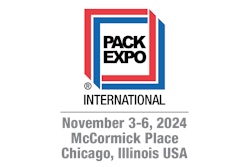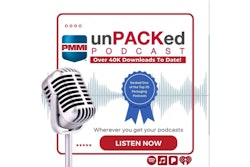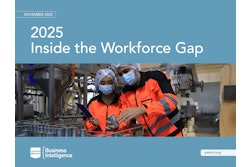In this episode, we explore the booming trends in packaging and processing automation – from insightful industry reports to the cutting-edge technologies embraced by CPG companies. Get a sneak peek into what PACK EXPO East offers, where attendees can explore the latest in automation capabilities and attend educational sessions right on the show floor.
Sean Riley: So with all the fancy introductions out of the way, welcome to the podcast, Tom.
Tom Egan: Thank you, Sean.
Sean Riley: So we're here to talk automation. It's all about automation. And I wanted to start with our business intelligence. What does PMMI say in its recent reports On what's happening with automation and the growth of automation?
Tom Egan: So the big picture is that automation is growing. The use of automation, both for the suppliers, the PMMI members that provide equipment, as well as the users who are demanding that continues to grow. There's actually a variety of reports that the PMMI Business Intelligence provides that I reviewed as we got ready for this going all the way back to October of 2022.
We have one called the Future of Automation in Packaging and Processing. We have another one from the same month about challenges and opportunities for packaging and producing processing operations. We have another one in February of 23 about sustainability and technology. And the latest one, which is one that I will draw on and would encourage.
All of the listeners to download is they want on trends in remote services and monitoring, and the one thing about that remote services and monitoring is that it covers more than just what we will nominatively refer to as remote access. It's remote services like remote training and remote monitoring of information.
So there's quite a number to draw on. I mentioned about the big item is that continues to grow. I think we also talk about in most of those, the need for training, including more advanced training with the expectation that the capabilities of the system that the operators of the packaging and processing equipment are using will need that advanced information.
Sean Riley: So you touched on remote monitoring and some remote services. What other technologies are being used by CPGs to automate their operations?
Tom Egan: Yeah, they are looking at doing that automated process and they're looking at a variety of technologies. They are moving up.
into the preventative maintenance and even the predictive maintenance approaches to keeping their machines in operation. They need that in that ability to continue to improve the ROI of the automation that they install. as well as the capabilities that are utilized by their teams. We have seen continual growth in robots and moving even into cobots now.
On the future you'll be looking and I'm sure you're reading topically our listeners are reading topically about humanoid robots, which are still pretty they're a new entry. We'll say that they're being used in some places. We also have all of the work that you're able to do with the remote access and a growing need there again to utilize that ROI capability. We want the machines to be up if there is an issue. Should there can there be a possibility for remote access for the production team by the suppliers of the equipment.
Sean Riley: So what are some of the other things that, that CPGs are trying to accomplish by using these technologies? I guess one of the things I'm thinking of is we have this labor issue that's constantly a thing in manufacturing and particularly in, in we're seeing in packaging and processing.
Is that something automation can be brought in to help out with? What are some other challenges that CPGs are trying to solve by utilizing automation?
Tom Egan: Sean, you've hit it. The workforce is a huge issue. So in addition to being able to keep the machines up and running, we need that trained workforce in order to be able to reliably operate the equipment and really.
draw from it all the capabilities that the machine solutions provide. I think that the need for doing some more advanced training is an important element that the CPGs are tracking with. I think also that information about what they're looking for, a greater automation to be able to monitor the line remotely, even for their own production operations is something that we've seen in the past years.
And it's continuing to grow. So the, that workforce element though, with remote training, the need for more capabilities, even the introduction of some new technologies we've heard from a number of CPGs. I don't. Know that it's a majority. I don't know that I would say it's close to a majority. Now, I will say it's growing, which is the ability of tablets to provide production information in the production environment.
So moving away from those fixed operator stations, even with the big KPI boards and going more to a tablet capability, which makes the operator a bit more mobile.
Sean Riley: That's interesting because we've touched on A skilled workforce shortage. So that would bring in people who might not be. As higher up in terms of their years in the plant, years in operations, years of training to be able to work right away as most, the generations coming in are familiar with working on iPads and iPhones and things like that.
Tom Egan: We are having a number of resignations of changes in the transitions in the workforce, even as we have multiple generations still in the workforce, it is changing and we're bringing in more individuals. that are pretty comfortable with what a tablet can do and being able to change the look of the tablet in order to make it work for themselves and to provide the information they want.
So that ability to operate with it, it's interesting. One participant in a meeting that PMMI Help to develop mentioned that it's also an understanding that the interface with the tablet using your fingers to swipe to draw down other menus is different than using a keyboard. And it seems like that's not a big thing until you realize that.
The newer workers coming in are completely capable and comfortable with that.
Sean Riley: What are some other tools and resources that companies can use in their journey towards automation?
Tom Egan: PMMI has developed a number through a couple of groups. One of them is called the OpX Leadership Network. And I'd encourage you to take a look. It’s opxleadershipnetwork.org. This is a group of packaging professionals that have gotten together to address issues of common concern, and so we put out a number of what we call work products, best practices that are brought by professionals that are involved right with production operations. One of them was about six years ago called Remote Access.
Still a very good document and in fact is being updated right now. Another one that I found very interesting was one that PMMI released in the middle of last year and it was actually aimed at PMMI members. It's available to everyone because of the value of the information and it was discussing how to talk to Your customer about remote access remote monitoring.
It's the idea of understanding the discussion of what the objectives of the customer are. Another important element for the customer that we saw on still a third report. Which is the understanding the digital journey of the consumer packaged goods companies. And also available on the OpX Leadership Network is the appreciation that there has to be an idea of where they want to get to.
And there has to be a very good understanding of where they're starting, what their base of assets are, including their workforce, and what it is that they need to do to bring that group up to a base level that can begin to really utilize the technologies that we're talking about. So it's not just highly automated equipment.
It's understanding the information you're able to get from it and what you're able to do with that information.
Sean Riley: Fascinating Now taking all that into consideration, how do these, companies that are looking to invest in automation. How do they tie all this information together? Do you have any recommendations on how people can start their automation journey?
Tom Egan: I recommend that information that we have about the IIoT journey that's on opxleadershipnetwork.org. And I do go back and emphasize those couple of points. One is to understand where you want to get. A number of years ago in an in another area when this was just starting, there was a great document that was put out just basically showing the levels, if you will.
One was a mostly manual operation. A next level up was in a semi automatic to automatic operation. A third level up was where things were machines, not things, but machines were interconnected and linked some to a higher level information systems. And then the last one is a fully automated system.
The piece that I like to look at there is there, there may be a point where the Consumer package goods team looks and says we only need to reach this level with this particular piece of equipment. Perhaps it's a Rainbow, pack system that they're doing which is a semi automated process, right?
They'll the different material that goes on to The palette will be brought in from different lines the idea though is that it is not so sophisticated that you're getting predictive maintenance from it because it's made to Do a one off palette and then the next one is going to be configured a bit differently.
So that understanding of what you want to achieve. Then go back and really look at the resources that you have and there the resources are the people and the equipment and the Services including such basic elements as internet service in your production operation so that you can look at that and say, okay Here's where we are.
Here's where we need to go to get to a new base level so that we can really use the tools that are available to us through all these processes. It's a great point that you're asking about. And I think an important one for both the consumer package goods company to focus on and then for the suppliers to understand when they're coming in and suggesting some solutions.
Sean Riley: So I would be remiss if I don't mention PACK EXPO East and then that's coming up soon. And what kind of, I don't know if you can give us some automation technologies or maybe some of the educational sessions at PACK EXPO East that we could highlight. That would really be of help to people that are either starting or in the middle of, or have been, familiar with automation technology.
Tom Egan: Yeah. I'm glad you're reminding me of it. March 18th to 20th at the Philadelphia convention center. I'll be there. I know you will be also look forward to welcoming. A whole number of individuals and teams from the different consumer packaged goods. What you're going to see there is the full range of automation capability.
Everything that companies are providing on their individual machines. Some of those different services and capabilities that I mentioned earlier in the podcast, such as that remote training capability, being able to utilize the information that is the expertise of the OEM And to help train as you develop a new workforce in your production environment, you'll see some co bots.
You'll see quite a bit of automated robotics associated with individual machines. You'll see control systems and all of the reporting capability that you're able to provide. And Sean, you mentioned, and I think it's extremely valuable. Take a couple of times where we talk about the different innovation stage presentations.
They're free to the attendee. We list what's going to be discussed, and these are opportunities for the suppliers to talk about a particular technology. And as an attendee, you get to walk up, sit down, hear what they have to say 25 minutes, and then you're back on and looking and visiting. And the last thing, of course, is that one to one networking and interaction with all exhibitors.
You have a chance to meet with them individually. Touch the equipment and then talk to them about what it is that their team could provide to help meet the goals that you have in your production operation.
Sean Riley: Perfect. This was great. This was a perfect summation on people regardless of where they are in their automation journey.
But definitely for people who are. or newer or trying to to start their automation journey. So I want to thank you again, Tom, for taking time out of your day to come on here with us.
Tom Egan: Hey, Sean, I appreciate the opportunity. It's great to have a chance to talk about it. Even better to have a chance to meet everybody at PACK EXPO East and say hello and then get them directed to the potential solutions that they're seeking there.





















